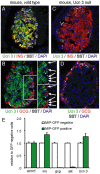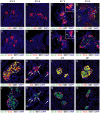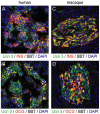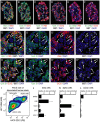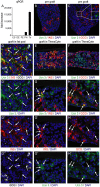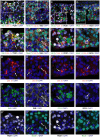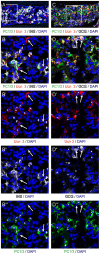Urocortin 3 marks mature human primary and embryonic stem cell-derived pancreatic alpha and beta cells - PubMed (original) (raw)
Urocortin 3 marks mature human primary and embryonic stem cell-derived pancreatic alpha and beta cells
Talitha van der Meulen et al. PLoS One. 2012.
Abstract
The peptide hormone Urocortin 3 (Ucn 3) is abundantly and exclusively expressed in mouse pancreatic beta cells where it regulates insulin secretion. Here we demonstrate that Ucn 3 first appears at embryonic day (E) 17.5 and, from approximately postnatal day (p) 7 and onwards throughout adult life, becomes a unifying and exclusive feature of mouse beta cells. These observations identify Ucn 3 as a potential beta cell maturation marker. To determine whether Ucn 3 is similarly restricted to beta cells in humans, we conducted comprehensive immunohistochemistry and gene expression experiments on macaque and human pancreas and sorted primary human islet cells. This revealed that Ucn 3 is not restricted to the beta cell lineage in primates, but is also expressed in alpha cells. To substantiate these findings, we analyzed human embryonic stem cell (hESC)-derived pancreatic endoderm that differentiates into mature endocrine cells upon engraftment in mice. Ucn 3 expression in hESC-derived grafts increased robustly upon differentiation into mature endocrine cells and localized to both alpha and beta cells. Collectively, these observations confirm that Ucn 3 is expressed in adult beta cells in both mouse and human and appears late in beta cell differentiation. Expression of Pdx1, Nkx6.1 and PC1/3 in hESC-derived Ucn 3(+) beta cells supports this. However, the expression of Ucn 3 in primary and hESC-derived alpha cells demonstrates that human Ucn 3 is not exclusive to the beta cell lineage but is a general marker for both the alpha and beta cell lineages. Ucn 3(+) hESC-derived alpha cells do not express Nkx6.1, Pdx1 or PC1/3 in agreement with the presence of a separate population of Ucn 3(+) alpha cells. Our study highlights important species differences in Ucn 3 expression, which have implications for its utility as a marker to identify mature beta cells in (re)programming strategies.
Conflict of interest statement
Competing Interests: The authors have read the journal's policy and have the following conflicts: OGK is an employee of Viacyte, receiving salary and/or stock options. The paper describes or references intellectual property owned by Viacyte. This does not alter the authors' adherence to all the PLOS ONE policies on sharing data and materials. The other authors declare that no competing interests exist.
Figures
Figure 1. Ucn 3 expression in adult mouse islets is restricted to beta cells.
Ucn 3 immunoreactivity overlaps completely with insulin (A) and not glucagon (B). Staining of the pancreas of a Ucn 3 null littermate demonstrates complete abrogation of Ucn 3 immunoreactivity to confirm the specificity of our antiserum (C, D). Details of panel C without glucagon (top) or somatostatin (bottom) channel reveals no Ucn 3 signal in alpha cells (arrows) or delta cells (asterisks). Expression profiling of dissociated FACS-sorted primary mouse beta cells from MIP-GFP transgenic mice demonstrates that purified beta cells have lost glucagon and somatostatin expression and are enriched for insulin and Ucn 3 expression (E). Note that both insulin and Ucn 3 expression remain present in the GFP-negative fraction due to the mosaic expression of the GFP reporter in this transgenic line.
Figure 2. Ucn 3 expression trails the appearance of insulin in ontogeny.
Ucn 3 expression, undetectable by immunohistochemistry at E12.5 (A, B) and E15.5 (C, D), first appears in a subset of beta cells around E17.5 of embryonic development (E, F). The fraction of Ucn 3+ beta cells increases perinatally (G, H) and by p7, the majority of beta cells (I, J), including those appearing as singlets in the acinar tissue (K) are clearly Ucn 3+. From p14 onwards, Ucn 3 expression is evident in all beta cells (L–O).
Figure 3. Ucn 3 expression in the primate pancreas is a feature of alpha and beta cells.
Ucn 3 immunoreactivity co-localizes with insulin as well as glucagon in both human (A, B) and macaque (C, D) pancreas.
Figure 4. Ucn 3 is expressed in alpha and beta cells in freshly fixed human islets.
Serial sections of the same human islet demonstrate that Ucn 3 expression co-localizes with insulin (A) and glucagon (B), but not somatostatin. The same islet shows no immunoreactivity for the related peptide Ucn 1 using an antiserum similar to the one used for the detection of Ucn 3 (C, D). Additional controls stained with secondary antibody only are negative as well (E, F). High power magnifications illustrate that the large majority of beta (G) and alpha (H) cells co-express Ucn 3 (arrows), although occasional insulin+ and glucagon+ cells can be found that do not stain for Ucn 3 (asterisks in G and H). Ucn 3 gene expression in FACS-purified dissociated human islet cells (I) from three individual donors confirmed that Ucn 3 is enriched in human beta (J) and alpha cells (K). The acinar cell fraction was depleted for the expression of all endocrine markers (L). Gene expression is normalized to HPRT and expressed relative to pre-sort levels. Error bars indicate standard errors, asterisks reflect significant differences at a p-value <0.05 as determined by t-test.
Figure 5. Expression of Ucn 3 in hESC-cell derived alpha and beta cells requires in vivo maturation.
Quantitative PCR analysis of key differentiation stages towards the human beta cell lineage reveals no Ucn 3 expression at the embryonic stem cell (ES) or definitive endoderm (DE) stage. While pancreatic cultures enriched for pancreatic endoderm cells (PE) by CD142 did not express Ucn 3, polyhormonal cells (PH) enriched from the same cultures by CD200, started to express Ucn 3. Implants of hESC-derived pancreatic progenitors robustly express Ucn 3 after differentiation and maturation in vivo at 140 days post-transplant (Tx). Ucn 3 expression is measured by qRT-PCR, normalized to TATA-box binding protein (TBP) and plotted relative to ES cells (A). These observations are confirmed on in vitro differentiated hESC-derived pancreatic endoderm, which contains a minor fraction of polyhormonal cells that express insulin (B) and glucagon (C), but are mostly devoid of Ucn 3 immunoreactivity with the exception of faint Ucn 3 expression in the occasional glucagon+ cell (C, inset). Ucn 3 immunoreactivity is robustly upregulated 18 weeks following engraftment in the epidydimal fat pads of mice and demonstrates significant Ucn 3 colocalization with insulin+ beta cells and glucagon+ alpha cells (D). Ucn 3 immunoreactivity is robustly upregulated 140 days post implantation in TheraCyte encapsulation devices and co-localizes with both insulin (E) and glucagon (F). Heterogeneity exists among both alpha and beta cells regarding the expression of Ucn 3. Arrows indicate Ucn 3+ cells that co-express insulin (G) or glucagon (H).
Figure 6. Ucn 3 expression co-localizes with Pdx1 and Nkx6.1 in beta cells but not in alpha cells.
Ucn 3 in beta cells differentiated in implants of hESC-derived pancreatic endoderm cells co-labels with Pdx1 (A, B) or Nkx6.1 (C, D). Ucn 3 in glucagon+ alpha cells does not co-localize with Pdx1 (E, F) or Nkx6.1 (G, H). Arrows in all panels indicate Ucn 3+ alpha cells, whereas asterisks denote Ucn 3+ mature beta cells. Boxed areas in the first row of images are magnified in subsequent panels.
Figure 7. Ucn 3 expression in freshly fixed human islets co-localizes with PC1/3 in beta cells but not in alpha cells.
Ucn 3 expression in human insulin+ beta cells coincides with PC1/3 (A), while Ucn 3+ glucagon+ alpha cells do not express PC1/3 (B). Arrows in all panels indicate Ucn 3+ alpha cells, whereas asterisks denote Ucn 3+ mature beta cells.
Figure 8. Ucn 3 expression in hESC-derived beta cells co-localizes with PC1/3.
Ucn 3 in beta cells differentiated in implants of hESC-derived pancreatic endoderm cells co-labels with PC1/3 (A, B), while Ucn 3 in glucagon+ alpha cells does not (C, D). Arrows in all panels indicate Ucn 3+ alpha cells, whereas asterisks denote Ucn 3+ mature beta cells. Pound signs indicate insulin+, PC1/3+ Ucn 3- immature beta cells. Boxed areas in the first row of images are magnified in subsequent panels.
Figure 9. Ucn 3 expression is acquired upon implantation of polyhormonal cells that differentiate primarily into alpha cells.
Implantation of hESC-derived pancreatic cultures, either non-enriched (A) or enriched for pancreatic endoderm by CD142 (B) in the epidydimal fat pad for 9 weeks supports the formation of alpha and beta cells that co-express Ucn 3. In contrast, implantation of CD318-enriched polyhormonal cells leads to the formation of predominantly alpha cells that co-express Ucn 3, with no detectable expression of insulin (C).
Similar articles
- Enrichment of human embryonic stem cell-derived NKX6.1-expressing pancreatic progenitor cells accelerates the maturation of insulin-secreting cells in vivo.
Rezania A, Bruin JE, Xu J, Narayan K, Fox JK, O'Neil JJ, Kieffer TJ. Rezania A, et al. Stem Cells. 2013 Nov;31(11):2432-42. doi: 10.1002/stem.1489. Stem Cells. 2013. PMID: 23897760 - Pdx1 and Ngn3 overexpression enhances pancreatic differentiation of mouse ES cell-derived endoderm population.
Kubo A, Stull R, Takeuchi M, Bonham K, Gouon-Evans V, Sho M, Iwano M, Saito Y, Keller G, Snodgrass R. Kubo A, et al. PLoS One. 2011;6(9):e24058. doi: 10.1371/journal.pone.0024058. Epub 2011 Sep 13. PLoS One. 2011. PMID: 21931641 Free PMC article. - Establishment of a rapid and footprint-free protocol for differentiation of human embryonic stem cells into pancreatic endocrine cells with synthetic mRNAs encoding transcription factors.
Ida H, Akiyama T, Ishiguro K, Goparaju SK, Nakatake Y, Chikazawa-Nohtomi N, Sato S, Kimura H, Yokoyama Y, Nagino M, Ko MSH, Ko SBH. Ida H, et al. Stem Cell Res Ther. 2018 Oct 25;9(1):277. doi: 10.1186/s13287-018-1038-3. Stem Cell Res Ther. 2018. PMID: 30359326 Free PMC article. - Maturation of stem cell-derived beta-cells guided by the expression of urocortin 3.
van der Meulen T, Huising MO. van der Meulen T, et al. Rev Diabet Stud. 2014 Spring;11(1):115-32. doi: 10.1900/RDS.2014.11.115. Epub 2014 May 10. Rev Diabet Stud. 2014. PMID: 25148370 Free PMC article. Review. - Evidence for a Neogenic Niche at the Periphery of Pancreatic Islets.
Huising MO, Lee S, van der Meulen T. Huising MO, et al. Bioessays. 2018 Nov;40(11):e1800119. doi: 10.1002/bies.201800119. Epub 2018 Sep 28. Bioessays. 2018. PMID: 30264410 Free PMC article. Review.
Cited by
- Pretransplant HOMA-β Is Predictive of Insulin Independence in 7 Patients With Chronic Pancreatitis Undergoing Islet Autotransplantation.
Beamish CA, Gaber AO, Fraga DW, Hamilton DJ, Sabek OM. Beamish CA, et al. Transplant Direct. 2022 Sep 16;8(10):e1367. doi: 10.1097/TXD.0000000000001367. eCollection 2022 Oct. Transplant Direct. 2022. PMID: 36204182 Free PMC article. - Gut-Brain Neuroendocrine Signaling Under Conditions of Stress-Focus on Food Intake-Regulatory Mediators.
Stengel A, Taché Y. Stengel A, et al. Front Endocrinol (Lausanne). 2018 Aug 28;9:498. doi: 10.3389/fendo.2018.00498. eCollection 2018. Front Endocrinol (Lausanne). 2018. PMID: 30210455 Free PMC article. Review. - Outbred Mice with Streptozotocin-Induced Diabetes Show Sex Differences in Glucose Metabolism.
Kim B, Park ES, Lee JS, Suh JG. Kim B, et al. Int J Mol Sci. 2023 Mar 8;24(6):5210. doi: 10.3390/ijms24065210. Int J Mol Sci. 2023. PMID: 36982285 Free PMC article. - All mixed up: defining roles for β-cell subtypes in mature islets.
Liu JS, Hebrok M. Liu JS, et al. Genes Dev. 2017 Feb 1;31(3):228-240. doi: 10.1101/gad.294389.116. Genes Dev. 2017. PMID: 28270515 Free PMC article. Review. - Urocortin 3 Levels Are Impaired in Overweight Humans With and Without Type 2 Diabetes and Modulated by Exercise.
Kavalakatt S, Khadir A, Madhu D, Hammad M, Devarajan S, Abubaker J, Al-Mulla F, Tuomilehto J, Tiss A. Kavalakatt S, et al. Front Endocrinol (Lausanne). 2019 Nov 6;10:762. doi: 10.3389/fendo.2019.00762. eCollection 2019. Front Endocrinol (Lausanne). 2019. PMID: 31781037 Free PMC article.
References
- Huising MO, Vale WW (2008) CRF and Urocortins: binding proteins and receptors. Encyclopedia of Neuroscience.
- Kuperman Y, Chen A (2008) Urocortins: emerging metabolic and energy homeostasis perspectives. Trends Endocrinol Metab 19: 122–129. - PubMed
- Li C, Chen P, Vaughan J, Blount A, Chen A, et al. (2003) Urocortin III is expressed in pancreatic beta-cells and stimulates insulin and glucagon secretion. Endocrinology 144: 3216–3224. - PubMed
Publication types
MeSH terms
Substances
Grants and funding
- P01 DK026741/DK/NIDDK NIH HHS/United States
- R01 DK068471/DK/NIDDK NIH HHS/United States
- U01 DK089567/DK/NIDDK NIH HHS/United States
- P01 DK026741-31/DK/NIDDK NIH HHS/United States
LinkOut - more resources
Full Text Sources
Other Literature Sources
Molecular Biology Databases
Research Materials
Miscellaneous
